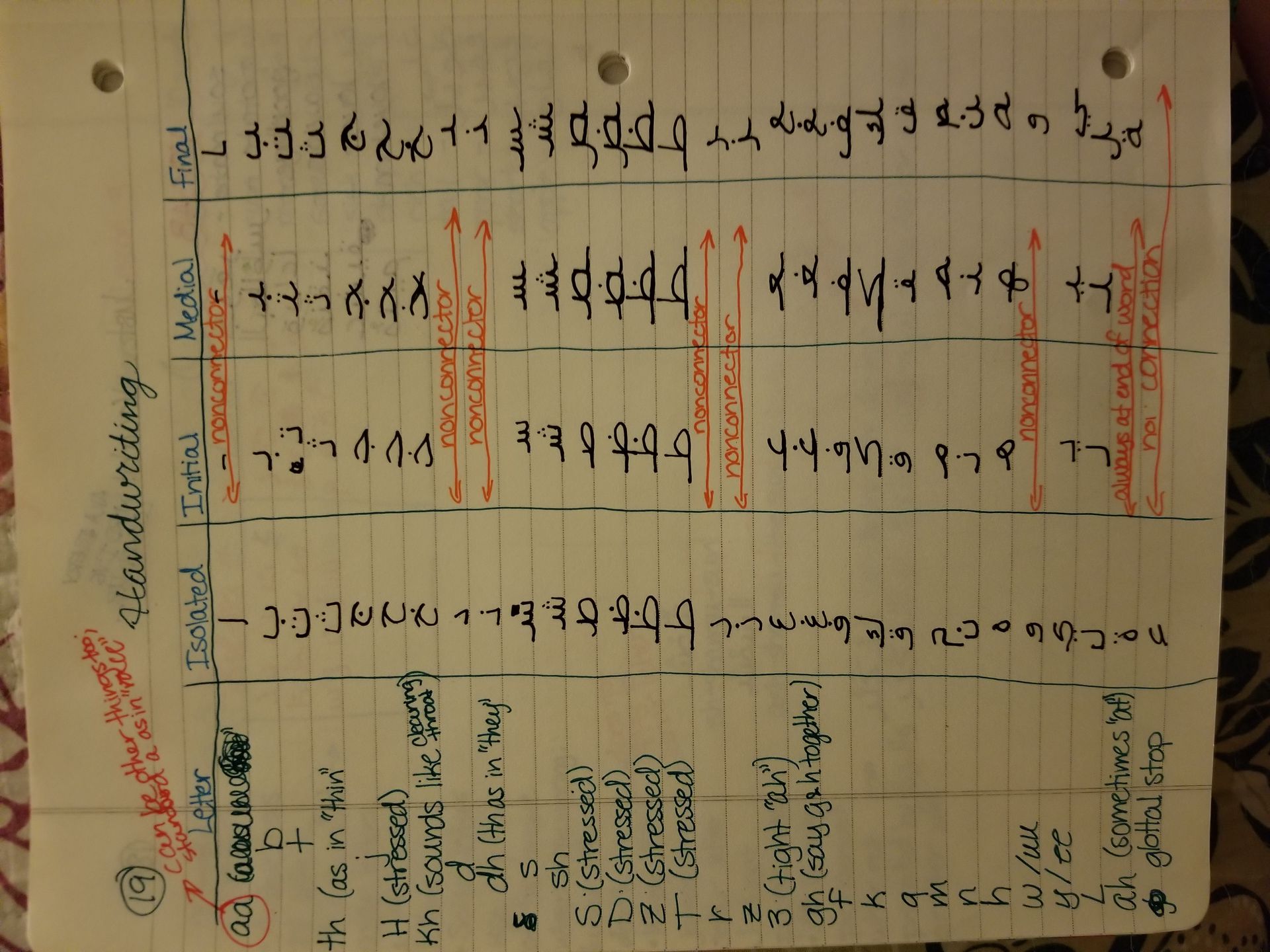WRITING SYSTEM: Consonants
Things you must know about the Arabic writing system before beginning:
- It's written and read from right to left.
- It's written in cursive.
- There are no upper or lowercase letters.
- Short vowels are written as markings above or below the letters and are called DIACRITICS. They are not seen in the real world, so it's best to familiarize yourself with the words so when you see درس you think "dars" (lesson) and not "drs".
Arabic writing:
- There are 28 letters in the alphabet, plus two extra characters.
- 22 of these letters are "connectors", meaning they have 4 forms:
• isolated: letter is alone and not connected to any other part of the word
• initial: letter is connected to just the letter after it (goes at beginning of the word)
• medial: letter is connected to both the letters before and after it
• final: letter is connected to just the letter before it (goes at the end of a word)
- 6 of these letters are "non-connectors", meaning that they only connect to the letter before them - they only have an isolated and final form.
If this sounds confusing, don't worry. Below I have a table of Arabic letters with their different forms.

(Apologies for the sideways picture....blame Wattpad)
NAMES OF LETTERS:
aalif
ا
baa
ب
taa
ت
thaa
ث
jeem (j as in Jaques)
ج
Haa (stressed)
ح
khaa (like clearing your throat)
خ
dal
د
dhal (th as in "they")
ذ
seen
س
sheen
ش
Saad (stressed)
ص
Daad (stressed)
ض
Zaa (stressed)
ظ
Taa (stressed)
ط
raa
ر
zayn
ز
3yn (tight "ah")
ع
ghayn (g and h together)
غ
faa
ف
kaf
ك
qaf (q is softer and farther back in the throat)
ق
meem
م
nun
ن
haa
ه
waw
و
yaa
ي
laam
ل
taa marbutaat
ة
hamza
ء
Let's talk about the hamza (ء):
The hamza represents a glottal stop in the word, where the air tract contracts and releases again. It's usually transliterated as a 2 or an apostrophe.
The symbol is not in English, but the sound is quite common. Think of the space between "uh-oh" or "great time". Anytime a hamza is seen in a sentence, you close your airways momentarily and release. A good example is listening to a Saudi say "Qur'an". There are audio clips on Youtube if you're interested.
Let's talk about Alif (ا):
Unlike most Arabic letters, Alif has several pronunciations.
Plain alif (ا): a as in race.
Alif with hamza on top (أ): glottal stop + a as in race, even in the middle of the word.
Alif with hamza on bottom (إ): glottal stop + i as in hit, even in middle of word.
Alif with a long mark (آ): a as in father.
Let's talk about laam-alif (ا + ل):
When you write Alif after laam, it looks like this: لا. By itself, it means "no" in Arabic.
=====
How to practice:
Take a piece of paper. Write each letter 20 times, saying the sound it makes each time. This will familiarize you with the sound it makes.
=====
Next up....
Diacritics (vowel markings), numerals, and punctuation - oh my!

Bạn đang đọc truyện trên: Truyen247.Pro